Breed-related disease: Cymric cat
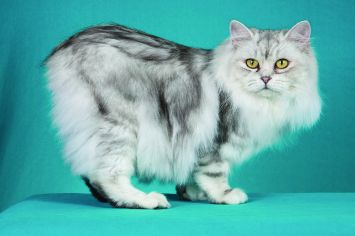
Is it really a cat if it doesn’t have a tail? It is if it’s a Cymric (pronounced kim-rick). There are lots of cats with short tails or no tails, but the Cymric (and his sister breed the shorthaired Manx) is the only one specifically bred to be tail-free. Sometimes jokingly said to be the offspring of a cat and a rabbit (however cute the idea, a “cabbit” is biologically impossible), these particular tailless cats are the result of a natural genetic mutation that was then intensified by their remote location on the Isle of Man, off the coast of Britain. The cats are thought to date to 1750 or later, but whether a tailless cat was born there or arrived on a ship and then spread its genes throughout the island cat population is unknown. The island became known for tailless cats, and that is how the breed got its name of Manx. The Manx has long been recognized by the Cat Fanciers Association, The International Cat Association, and other cat registries. A longhaired version was accepted by CFA as a division of the Manx in 1994. In some associations, the longhaired Manx is called a Cymric and is considered a separate breed. The overall appearance should be that of a medium-sized, compact, muscular cat. The Cymric has a round head with a firm muzzle and prominent cheeks, short front legs, height of hindquarters, great depth of flank, and a short back, which forms a smooth continuous arch from the shoulders to the round rump. The Manx and Cymric are essentially the same in all respects, the Cymric having a longer coat. The Cymric has a medium/semi-long coat with a silky texture, which varies with coat color. Britches, tufts of hair between the toes and full furnishings in the ears distinguish the Cymric. The personality of the Cymric has won a strong following. Cymrics are intelligent, fun-loving cats, and they get along well with other pets, including dogs. Cymrics are particularly noted for their loyalty to their humans and enjoy spending quality time with them. As cats go, they can be easily taught tricks. Despite their playful temperament, they are gentle and nonaggressive. Here below, we listed some of the most common diseases to look for in your Cymric: Congenital Vertebral Malformations Sacrocaudal dysgenesis is a form of spinal deformity commonly seen in Cymric kittens. The sacrum is the part of the spine that passes through the pelvis, caudal means “towards the tail”, and dysgenesis means improper formation during fetal development. Sacrocaudal dysgenesis, then, means that the tail end of the spine forms improperly during fetal development—a common problem when a cat’s tail is genetically programmed to be missing. Affected kittens whose spine and spinal nerves aren’t functioning correctly may have fecal or urinary incontinence, or may walk with a hopping, abnormal gait. Constipation and megacolon are also more common in affected cats, and the effects of the condition typically worsen with age. Megacolon Megacolon is a serious and chronic form of constipation caused by a defect in the nerve supply to the intestines. Cats with megacolon have an insufficient number of nerves linked to the muscles of the colon and are unable to pass stool properly. As the cat gets older, the condition worsens, causing an increase in discomfort and blockage. Each time the cat is constipated, the intestines are stretched, bruised, and further damaged. This damage leads to larger and harder stools and, eventually, complete blockage. Megacolon is a life-threatening condition, but early and aggressive treatment can delay or prevent the necessity of major surgery to remove the colon. FLUTD When your cat urinates outside the litter box, you may be annoyed or furious, especially if your best pair of shoes was the location chosen for the act. But don’t get mad too quickly—in the majority of cases, cats who urinate around the house are sending signals for help. Although true urinary incontinence, the inability to control the bladder muscles, is rare in cats and is usually due to improper nerve function from a spinal defect, most of the time, a cat that is urinating in “naughty” locations is having a problem and is trying to get you to notice. What was once considered to be one urinary syndrome has turned out to be several over years of research, but current terminology gathers these different diseases together under the label of Feline Lower Urinary Tract Diseases, or FLUTD. Sources: https://ahcfargo.com/client-resources/breed-info/cymric-longhaired-manx-2/ https://cattime.com/cat-breeds/cymric-cats#/slide/1 Photo credit: https://en.wikipedia.org/wiki/Cymric_cat https://www.petfinder.com/cat-breeds/cymric/
Breed-related disease: Maltese dog
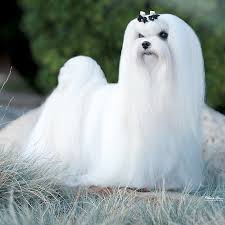
John K. Rosembert The Maltese is an ancient breed, one of several small “bichon” dogs found around the Mediterranean for thousands of years. His exact place of origin is a mystery, with conjecture including Sicily, Egypt, and southern Europe, but most historians pinpoint Malta for the development of the breed. With its teeny-tiny stature, flowing white coat, and high trainability, this toy breed has beauty and brains. For that, it’s been cherished since its earliest days in ancient Italy and has long been seen as a portable and charming companion. The Maltese puppy truly is the quintessential lap dog, with its fluffy white fur, adorable black-button nose, dark eyes, and sprightly demeanor. “They’re like a little stuffed animal,” Derse says. The Maltese has a compact, athletic body, small floppy ears, and a tufted tail that curves over her back. By the time a Maltese reaches her full 7–9 inch height and 4–6 pound weight, those white tresses become silky smooth, requiring daily brushing along with regular baths to maintain their regal appearance. If you’re looking for a friendly dog with elegance and charm, look no further than the Maltese! With their silky, pure white coats and warm temperaments, it’s no surprise that they’ve made popular companions for people for centuries. People fall head over heels for this breed because of its adorable look, but their loyal personality makes them a fantastic option for anyone that’s looking for a canine friend. You will find no lack of adorableness, loyalty, or intelligence in this famous toy dog breed. Like other toy breeds, Maltese are prone to certain health issues. However, some of these conditions can be prevented if you keep up with routine care and checkups, here below we listed some of the most common illnesses run in their genes… Let’s get started: Inflammatory Bowel Disease Other common health conditions Maltese face affect their intestines. The breed can also develop severe food allergies and sensitivities. Inflammatory Bowel Disease, or IBD for short, occurs when your dog’s intestines become overactive with lymphocytes and plasmacytes. These are immune cells that attack harmful organisms in your dog’s gut, but they can cause vomiting and diarrhea when they become overactive. Diet and lifestyle changes will help this condition. Epilepsy Seizures and epilepsy can occur in Maltese as well. These conditions tend to be genetic, so if the dog’s parents or other direct relatives have a history of seizure, then your dog will have a higher chance of experiencing them. Because Maltese dogs have low body weight, they are at risk of experiencing hypoglycemic seizures. Hypoglycemic seizures are caused by low blood sugar levels. Seizures start as an excessive surge of electrical activity in the brain. The surge becomes excessive and overwhelms the neurons, resulting in a temporary malfunction of the brain. Depending on which regions of the brain are affected, a seizure manifests as muscle spasms or other symptoms. Knee Problems Sometimes your Maltese’s kneecap (patella) may slip out of place (called patellar luxation). You might notice that he runs along and suddenly picks up a back leg and skips or hops for a few strides. Then he kicks his leg out sideways to pop the kneecap back in place, and he’s fine again. If the problem is mild and involves only one leg, your friend may not require much treatment beyond arthritis medication. When symptoms are severe , surgery may be needed to realign the kneecap to keep it from popping out of place. Heart murmurs, congestive heart failure This is most often seen with senior Maltese dogs age 10 and up. Because heart murmurs rarely have any outward signs, this is usually discovered during a wellness check when the veterinarian is listening to the dog’s heart. Murmurs do not always lead to congestive heart failure, but they can. These are graded on a scale from 1 to 6. Typically no treatment is required for a grade 1 to 3 murmur. However, this is often a progressive disease. If the murmur worsens to a grade 4, 5, or 6, there can be issues such as troubled breathing, coughing, and exercise intolerance. Sources: https://www.dailypaws.com/dogs-puppies/dog-breeds/maltese https://www.petmaltese.com/maltese-health https://www.holistapet.com/maltese-dog-breed-temperament-personality/ Photo credit: https://thehappypuppysite.com/maltese-lifespan/ https://maltaangelmaltese.com/about-us/
Breed-related disease: Birman Cat

The origin of the Birman cat is not well known, with much of his history tied in with cultural legends, While there is no clear record of the origin of Birman cats, one pair was taken to France around 1919, from which the breed became established in the western world. However, Birman cats were almost wiped out as a breed during World War II and were heavily outcrossed with long-hair breeds (mainly Persians) and also Siamese lines to rebuild the breed. By the early 1950s, pure Birman cat litters were once again being produced. The restored breed was recognized in Britain in 1965. The Birman, also known as the “Sacred Cat of Burma” is semi-longhaired with darker coloring to the points, face, legs, ears, and tail, and a pale toning body color. It is a largish cat with a thickset body and short legs.The Birman cat has blue eyes and four pure white feet. The front gloves covering only the feet, but the rear socks are longer. The head is broad and rounded with medium-size ears. They come in lots of different colors. The Birman is a calm, affectionate cat who loves to be around people and can adapt to any type of home. He likes to play chase with other pets, taking turns being the chaser and the one being pursued. Birmans make friends with kids, dogs , and other cats. In fact, unlike most felines, they don’t especially like being the “only pet,” so you may want to get your Birman a companion – he won’t care if it’s another Birman, a different breed of cat, or even a dog. Birmans aren’t demanding of your attention, but they’ll definitely let you know when they need a head scratch or some petting. Then they’ll go about their business until it’s time for you to adore them again. You should also keep your Birman entertained with interactive toys that require him to do some thinking and moving to pop out treats or kibble. Here we gathered for you the most common Genetic Predispositions about Birmans, let’s get started: Luckily, Birman cats are relatively healthy and aren’t predisposed to any major conditions. But, the common health concerns that plague other cats are things to look out for. These include obesity, hypertrophic cardiomyopathy, and kidney disease. Obesity Because of the hefty weight of these kitties, they may be more prone to feline obesity, which can cause a myriad of other health concerns. Just like humans, it’s important to do everything you can to help your kitty maintain a healthy weight. By limiting their food intake, exercising them regularly, and keeping up with regular vet visits, you can completely prevent this condition. It is up to the owner of Birmans to make sure they stay at a healthy weight. Hypertrophic Cardiomyopathy (HCM) Not specific to Birman cats, hypertrophic cardiomyopathy (HCM) is the most common heart condition in cats. It causes the walls of the heart muscle to thicken and can cause the heart to increase in size. This is a genetically inherited condition, and breeders can check their lines for this condition. HCM is something to always be aware of, even if your kitty has a clean bill of health. HCM ranges in severity and can be treated with supplements, herbs, and other natural remedies. Kidney Disease Some lines of modern Birman cats may descend from Persians, who are also prone to kidney disease. Because of this, Birmans may be more susceptible. Sources: https://canna-pet.com/breed/birman-cat/ https://www.purina.co.uk/cats/cat-breeds/library/birman Photo credit: https://prettylitter.com/blogs/prettylitter-blog/birman-cats-101-pretty-litter https://cats.lovetoknow.com/Birman_Cats
Breed-related disease: French bulldog

The “bouldogge Francais,” as he is known in his adopted home country of France, actually originated in England, in the city of Nottingham. Small bulldogs were popular pets with the local lace workers, keeping them company and ridding their workrooms of rats. After the industrial revolution, lacemaking became mechanized and many of the lace workers lost their jobs. Some of them moved to France, where their skills were in demand, and of course they took their beloved dogs with them. The dogs were equally popular with French shopkeepers and eventually took on the name of their new country. The little dogs became popular in the French countryside where lace makers settled. Over a span of decades, the toy Bulldogs were crossed with other breeds, perhaps terriers and Pugs, and, along the way, developed their now-famous bat ears. They were given the name Bouledogue Français. French bulldogs (Frenchies) are known for their quiet attentiveness. They follow their people around from room to room without making a nuisance of themselves. When they want your attention, they’ll tap you with a paw. This is a highly alert breed that barks judiciously. If a Frenchie barks, you should check it out. What’s not to like? Frenchies can be stubborn about any kind of training. Motivate them with gentle, positive techniques. When you find the right reward, they can learn quickly, although you will find that they like to put their own spin on tricks or commands, especially when they have an audience. All dogs have the potential to develop genetic health problems, just as all people have the potential to inherit a particular disease, The French Bulldog is prone to certain health problems. Here’s a brief rundown on what you should know. Ear Infections French Bulldogs have very narrow ear canals, and for this reason, are very vulnerable to ear infections. They are also susceptible to allergies which can give them these infections. Ear glands swell up to resist infections and produce more wax than normal. This leads to an overproduction of ear tissue, making the canal ever narrower, and inflamed. In severe cases the eardrum can rupture, causing your pooch a lot of pain! Look out for excessive ear scratching and redness inside the ear as warnings of this problem Diarrhea Stomach upsets are very common in Frenchies, so monitoring their diet is a must. Consistent bouts of diarrhea can be caused by parasites, viruses, or E. coli, all of which Frenchies are very sensitive to. Take note of their stools if they are wet, runny, or tarry, smell foul, or if you see blood in the stools. These are all signs of a serious digestion problem. Other tell-tale signs are your dog losing weight, losing their appetite, vomiting or having a fever. Conjunctivitis Again, due to the genetic makeup of French Bulldogs, they are at a high risk of suffering from conjunctivitis. This is because they are a short-nosed (brachycephalic) breed. It’s usually caused by bacterial and viral infections or allergic reactions to substances. Watch out for your Frenchie having pink or red eyes, if they start blinking more than usual, or have mucus, pus or discharge leaking from their eyes. Skin Problems – Skin Fold Dermatitis Due to French Bulldogs folded facial skin around their muzzle and nose, this can lead to dermatitis. It can also occur in other areas of their bodies that are folded, like armpits, necks, and crotches. Signs of this problem include itching, biting and scratching of the area, and redness and sores on the affected skin. Keeping skin folds dry and clean can prevent dermatitis from occurring. Skin Problems – Pyoderma (bacterial skin infection) Another common skin problem is bacterial skin infections. This occurs when your dog has a cut or scratch that becomes infected. Again, look out for itching, red skin, pus, and loss of hair around the cut. It’s another health problem that comes from having skin folds. Breathing Problems – URT Infection As a short-nosed breed, French Bulldogs are very at-risk of upper respiratory tract infections. These will usually happen to every bulldog at least once in their lives and are infectious, so will occur if your dog spends more time with other canines. Symptoms are a lot like human colds: nasal congestion, coughing, and lethargy. Breathing Problems – Brachycephalic Obstructive Airway Syndrome (BOAS) Sadly, many French Bulldogs are also at a high risk of BOAS due to their squashed faces and short snouts. This can lead to shortness of breath, trouble breathing, sleeping difficulties, and heat intolerance. You’ll notice this problem occurring during exercise and in warmer temperatures. Mobility Issues in French Bulldogs There is a range of conditions that can affect the Frenchie’s mobility. Ranging from congenital conditions, injuries, and degenerative disease. Conditions such as hip dysplasia and luxating patellas can be caused by genetic or caused by old injuries. Other conditions affecting Frenchies include IVDD, spinal disc issues, and degenerative myelopathy (DM). Sources: https://www.handicappedpets.com/blog/common-health-problems-in-frenchies/ http://www.vetstreet.com/dogs/french-bulldog#health Photo credit: https://en.wikipedia.org/wiki/French_Bulldog American kennel Club
Breed-related disease: Thai Cat

The Thai Cat is an old, but recently recognized breed that is related to the Siamese cat originated in Thailand, where it is actually referred to as the Wichien-Maat, which translates to “moon diamond.” This breed is also commonly referred to as the Traditional, or Old-Style, Siamese. In the 1800s, the first Wichien-Maat cats arrived in Great Britain as a gift to the royal family, where they soon become very popular. The Western breeders renamed the breed to Siamese and started to improve its looks with selective breeding. Thus emerged a cat with finely boned slimmer body, longer head, and more intense sapphire blue eyes. Eventually, the new-styled Siamese was the center of attention and many breeders preferred the new look over the original one. Luckily in the 1950s, some breeders enjoyed the original appearance of these cats and started to breed them to get the original qualities back into the breed. At this point, the two breeds started to diverge. And in 1990, the Thai name was given to cats that had the classic look of Traditional Siamese cats. Finally, in 2009, TICA gave the Thai an Advanced New Breed status. The Thai cat is a shorthaired cat breed that has a flat, short coat that is soft. Their bodies feature medium-sized bones in the legs, head, and tail. And they have a wedge-shaped muzzle, ears that are broad at the base, and a long, flat forehead that distinguishes it from other pointed breeds. These cats also have striking blue eyes that complement their pointed coat beautifully. The Thai is an attention-seeking and demanding breed that craves human companionship. These cats form deep bonds with their owners and will follow them around the house, this breed doesn’t understand the concept of privacy, and the Thai will shadow your every move . While being the center of your cat’s universe has its perks, this amount of devotion can sometimes be too much! Health and Potential Health Problems The Thai is generally a healthy breed that can live very long. Although they aren’t prone to an array of genetic health problems like some other cat breeds, certain issues have been observed in these cats. This doesn’t mean that your cat is going to be affected. However, it is better to learn about any potential problems before bringing a new cat home. Crossed eyes : This condition occurs when small muscles in the eye are stretched out and don’t allow normal movements of the eye. A cat can be born with this condition or develop it later in life. Cats that are born with it don’t experience any problems and have normal lives. However, if the condition appears later in life it is usually because of an underlying issue. Symptoms include uncoordinated eye movement, lack of movement in one eye, seizures, and lethargy. Treatment varies depending on the underlying issue and can include antibiotics or surgery. Kinked Tail : This condition is caused by a recessive gene and it is sometimes seen in Thai Cats. This means that even though both parents have normal tails a kitten can be born with a curled or kinked tail. This condition doesn’t affect the health of a cat. However, affected cats are disqualified from show rings. Gangliosidosis : It’s an inherited disease that causes a cat to lack an enzyme that is required to metabolize certain lipids., excess fats accumulate within the cells disrupting their normal function. Symptoms include in-coordinate walk, enlarged liver, tremors, and visual impairment They are usually observed in kittens between 1 to 5 months of age. Unfortunately, there is no cure for this disease and the affected kittens die when they are 8 months old. However, DNA testing is available and is used to improve breeding programs. Sources: https://www.petguide.com/breeds/cat/thai-cat/ https://thedutifulcat.com/thai-cat/ Photo credit: https://www.wikiwand.com/en/Thai_cat
Breed-related disease: Newfoundland
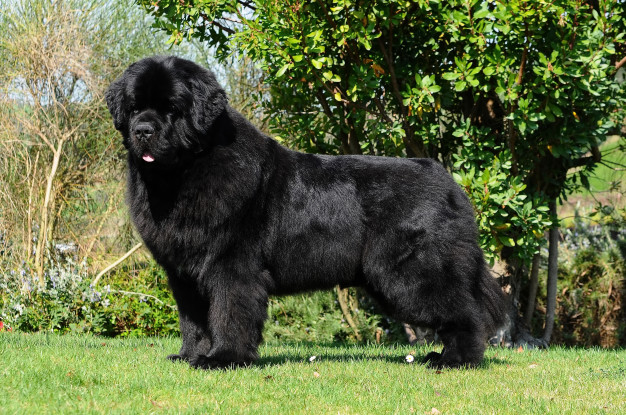
The Newfoundland is a large working dog. They can be either black, brown, grey, or white-and-black. However, in the Dominion of Newfoundland, before it became part of the confederation of Canada, only black and Landseer colored dogs were considered to be proper members of the breed. They were originally bred and used as working dogs for fishermen in Newfoundland. Because of its heavy coat, the Newfie does not fare well in hot weather. It should be kept outdoors only in cold or temperate weather , and in summer, the coat may be trimmed for neatness and comfort, and brushed daily to manage excess shedding and prevent the coat from matting. The dog is at its best when it can move freely between the yard and the house, but still needs plenty of space indoors to stretch properly. Daily exercise is essential, as is typical with all work dogs. Newfoundland is known for his intelligence, loyalty, and sweetness. Even though he is a terrific guard dog, his gentle and docile disposition makes him an excellent choice for as a family dog. He thinks he’s a lap dog, and loves to lean on people and sit on their feet. The Newfie is a natural lifesaver and can be a good assistant for parents who have a swimming pool or enjoy taking the kids to the lake or ocean, although he should never be solely responsible for their safety. Let it be said that the Newfie isn’t perfect, his heroic nature notwithstanding. Any dog, no matter how nice, can develop obnoxious levels of barking, digging, counter-surfing and other undesirable behaviors if he is bored, untrained or unsupervised. And any dog can be a trial to live with during adolescence. In the case of the Newfie, the “teen” years can start at six months and continue until the dog is about two years old. We know you care for your pet that’s why gather some of the various health problems that are common in the breed. Subaortic Stenosis (SAS) This is an inherited disease in Newfoundland’s, although the mode of inheritance appears complicated and is not yet completely understood. A ring of tissue forms below the aortic valve in the heart, restricting the blood flow and increasing the pressure within the heart. The heart tissue overgrows in response to the increased pressure, outgrowing its own blood supply and causing scar tissue to develop that interferes with the electrical impulses in the heart. Puppies can develop a murmur throughout their first year of life, but usually those with significant disease develop murmurs within the first 9 weeks of life. Occasionally, a puppy will have no murmur at a young age, but when checked again at one year, will have developed the disease. Pulmonic Stenosis (PS) In this disease a ring of tissue forms below the pulmonic valve in the heart. It causes murmurs and may affect the dog’s health and life span, depending on the severity and if it appears in conjunction with other defects. Allergies Newfoundland, as well as most other breeds of dogs may allergies to food, fleas, pollen or other environmental allergens. Typically allergies cause skin problems, recurring ear infections or digestive problems. Medications, proper parasite control, and sometimes diet changes can effectively manage many allergies. Panosteitis (Pano) This is a painful inflammatory bone disease of young, rapidly growing dogs. Pano causes lameness in the affected limb and the lameness may “rotate” among all four legs. It is usually a self-limiting condition that most dogs outgrow. The dog may require some limitation of activity, ie no free play, and anti-inflammatory medication if the pup is very painful. Pano commonly occurs between 6 months and 18 months, but is known to occur in older dogs, and tends to run in families. Source: http://www.newfhealthandrescue.org/health.html http://www.vetstreet.com/dogs/newfoundland#health Photo credit: https://www.freepik.com/premium-photo/purebred-newfoundland-dog_5575063.htm
Breed-related disease: Oriental Shorthair
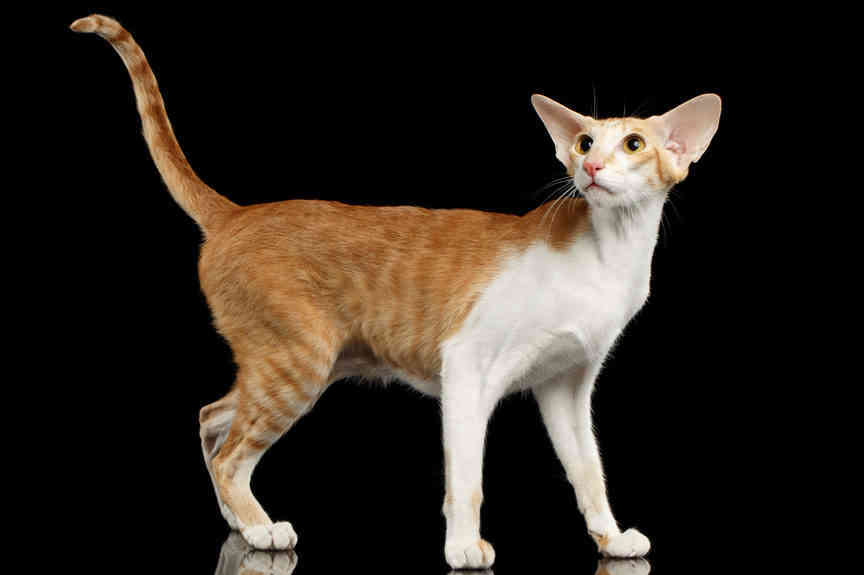
The Oriental Shorthair is actually a Siamese hybrid first developed in England in the 20th century. It is similar in body type to the Siamese, but comes in many more color and pattern varieties. And though it is not as communicative as the Siamese, the Oriental is still a fun companion to have around the house. Unlike the Siamese, the Oriental Shorthair comes in nearly 300 colors and patterns. Some popular styles include ebony, pure white, chestnut, and blue, while some popular patterns include solid, bi-color, and tabby. The cat have a short and sleek coat, long, slender and flexible with large ears and piercing almond-shaped eyes. They are passionate about the people in their lives. They become extremely attached to their humans, so be prepared for a lifetime commitment. It can be very difficult for these cats to adjust to the loss of their family or favorite person. When you are not available to entertain him, an Oriental will divert himself by jumping on top of the refrigerator, opening drawers, seeking out anyone hideaways to frustrate who might be searching for him, and watching television with clear interest. Both pedigreed cats and mixed-breed cats have varying incidences of health problems that may be genetic in nature. The same problems that may affect the Siamese can also affect the Oriental, including the following: Amyloidosis, a disease that occurs when a type of protein called amyloid is deposited in body organs, primarily the liver in members of the Siamese family Asthma/bronchial disease Congenital heart defects such as aortic stenosis Crossed eyes Gastrointestinal conditions such as megaesophagus Hyperesthesia syndrome, a neurological problem that can cause cats to excessively groom themselves, leading to hair loss, and to act frantically, especially when they are touched or petted Lymphoma Nystagmus, a neurological disorder that causes involuntary rapid eye movement Progressive retinal atrophy, for which a genetic test is available Sources: http://www.vetstreet.com/cats/oriental#health https://cattime.com/cat-breeds/oriental-cats Photo credit: Full of cats: https://fullofcats.com/cat-breeds/oriental-shorthair-cat/ yeswecatcattery: https://www.instagram.com/p/CC_oyCQoozZ/?igshid=cxwljznay7lz 🔎 Recommended Screening Products for Oriental Shorthair Cats Based on the breed’s predisposition to hereditary and immune-related diseases, we recommend including the following rapid test kits as part of your annual wellness program for Oriental Shorthairs: Screening Category Recommended Product Clinical Rationale FeLV / FIV Screening FeLV Ag Test, FeLV Ag / FIV Ab Combo Test, Feline 3X FeLV and FIV are highly associated with lymphoma and immune dysregulation. Annual screening is strongly advised. Feline Coronavirus & FIP Risk Assessment FCoV Ab Test, FCoV Ag Test, Feline 3DX Purebred cats such as Oriental Shorthairs have a higher susceptibility to FCoV. Early detection and serologic monitoring are recommended. Gastrointestinal Infectious Diseases Feline 3DX (FPV Ag / FCoV Ag / Giardia Ag) Useful for screening when vomiting, diarrhea, or chronic gastrointestinal signs are observed. Blood Type Identification Feline Blood Typing Kit Highly recommended prior to surgery or blood transfusion to prevent acute transfusion reactions. 📩 How to Order All rapid test kits listed above are available exclusively to licensed veterinarians and veterinary hospitals. To place an order or request a quotation, please contact our sales team or email our customer service: 📧 service@bioguardlabs.com ☎️ Please include your hospital name and contact number in the email so our sales representative can follow up with you directly.
Breed-related disease: Afghan Hound

Afghan hound, breed of dog developed as a hunter in the hill country of Afghanistan. It was once thought to have originated several thousand years ago in Egypt, but there is no evidence for this theory. It was brought to Europe in the late 19th century by British soldiers returning from the Indian-Afghan border wars. The Afghan hound hunts by sight and, in its native Afghanistan, has been used to pursue leopards and gazelles. The animal is adapted to rough country by the structure of its high, wide hipbones. A long-legged dog, the Afghan stands 25 to 27 inches (63.5 to 68.5 cm) high and weighs from 50 to 60 pounds (23 to 27 kg). It has floppy ears, a long topknot, and a long, silky coat of various but usually solid colours. The coat is especially heavy on the forequarters and hindquarters; the Afghan carries its slim tail in an upright curve. The Afghan’s appearance has been described as “aristocratic, with a farseeing expression.” The Afghan Hound is aloof and dignified, except when he’s being silly. Aloof doesn’t mean shy; he should never be afraid of people and is usually not aggressive toward them. He takes his time getting to know people outside his family. People who are fortunate enough to be allowed into his circle of friends will experience a dog with an exuberant nature and a wicked sense of humor. Afghans do everything to extremes. They are drama queens and food thieves, bossy and mischievous. They have a high prey drive, and although they may get along with the cats they were raised with, outdoor cats should fear for their lives when the Afghan springs into action. The Afghan is an independent thinker. He’s happy to do what you ask—as long as that’s what he wanted to do anyway. He’s highly intelligent and learns quickly, but he won’t always respond to your commands, er, requests. He’s thinking about it. Maybe he’ll do it later. Or not. This can make him frustrating to train and even more frustrating to compete with. Afghans have done well in sports such as agility and lure coursing, but only when their people have extreme patience, a never-ending sense of humor and a good command of positive reinforcement techniques to lure him into compliance. In this article we put some of the most important genetic predispositions for Afghan hounds Let’s get started: Heart Disease Afghan Hounds are prone to multiple types of heart disease, which can occur both early and later in life. We’ll listen for heart murmurs and abnormal heart rhythms when we examine your pet. When indicated, we’ll perform an annual heart health check, which may include X-rays, an ECG, or an echocardiogram, depending on your dog’s risk factors. Early detection of heart disease often allows us to treat with medication that usually prolongs your pet’s life for many years: Bone and Joint Problems A number of different musculoskeletal problems have been reported in Afghan Hounds. While it may seem overwhelming, each condition can be diagnosed and treated to prevent undue pain and suffering. With diligent observation at home and knowledge about the diseases that may affect your friend’s bones, joints, or muscles you will be able to take great care of him throughout his life. Anesthesia when it is time for a dental cleaning, surgery, or minor procedures such as suturing a wound, anesthesia is usually necessary. Afghan Hounds have a number of idiosyncrasies that can increase the risk of anesthesia. The good news is we have many years of experience with sighthounds and know to pay special attention to anesthetic problems such as: Hyperthermia (body temperature dangerously high) in nervous dogs Hypothermia (body temperature dangerously low) in dogs with a lean body conformation Prolonged recovery from some intravenous anesthetics and increased risks of drug interactions. Thyroid Problems Afghans are prone to a common condition called hypothyroidism in which the body doesn’t make enough thyroid hormone. Signs can include dry skin and coat, hair loss, susceptibility to other skin diseases, weight gain, fearfulness, aggression, or other behavioral changes. Chylothorax Afghans are more prone to an uncommon, but serious, condition called chylothorax where the chest cavity fills with a milky substance called chyle. In affected dogs, chyle accumulates in the chest cavity because of a faulty lymphatic duct called the thoracic duct. Chylothorax, while rare, is life threatening and requires immediate medical attention. Often surgery is need to help manage the disease. Watch for difficulty breathing, coughing or lethargy as these may be the first signs of this disease. Sources: https://wovh.com/client-resources/breed-info/afghan-hound/ http://www.vetstreet.com/dogs/afghan-hound#personality Photo credit: https://www.yourpurebredpuppy.com/health/afghanhounds.html http://www.vetstreet.com/dogs/afghan-hound#personality
Breed-related disease: Russian Blue Cat

Although the Russian blue’s exact origins are not known for certain, but the Russian Blue cat was originally known as the Archangel Cat because it was said to have arrived in Europe aboard ships from the Russian port of that name (Arkhangel’sk). It has also been known as the Spanish Cat and the Maltese cat, particularly in the US where the latter name persisted until the beginning of the century. The cat was favored by royals and preferred by the Russian czars. The Russian Blue cat is medium to large in size with an elegant, graceful body and long, slim legs. The cat walks as if on tip-toes. The head is wedged shaped with prominent whisker pads and large ears. The vivid green eyes are set wide apart and are almond shaped. The coat is double with a very dense undercoat and feels fine, short and soft. In texture the coat of the Russian Blue cat is very different from any other breed and is the truest measure of the breed. Although named the Russian Blue, black and white Russian cats do sometimes appear. In the most popular blue variety, the coat colour is a clear even blue with a silvery sheen. The Russian blue is a sweet-tempered, loyal cat who will follow her owner everywhere, so don’t be surprised if she greets you at the front door! While she has a tendency to attach to one pet parent in particular, she demonstrates affection with her whole family and demands it in return. It’s said that Russian blues train their owners rather than the owners training them, a legend that’s been proven true time and again. They are very social creatures but also enjoy alone time and will actively seek a quiet, private nook in which to sleep. They don’t mind too much if you’re away at work all day, but they do require a lot of playtime when you are home. Russian blues tend to shy away from visitors and may hide during large gatherings. As we know you care for your pet, below, we listed the few of the most common diseases in the animal Weight related problems. The Russian Blue cat really enjoys its food and it may continue to eat as much as it chooses. So, it’s best to limit the amount of food that the cat enjoys to ensure a healthy diet and to combat any weight related illnesses . Progressive retinal atrophy refers to a family of eye conditions which cause the retina’s gradual deterioration. Night vision is lost in the early stages of the disease, and day vision is lost as the disease progresses. Many cats adapt to the loss of vision well, as long as their environment stays the same. Polycystic kidney disease. PKD is a condition that is inherited and symptoms can start to show at a young age. Polycystic Kidney Disease causes cysts of fluid to form in the kidneys, obstructing them from functioning properly. It can cause chronic renal failure if not detected . Look for symptoms like poor appetite, vomiting, drinking excessively, frequent urination, lethargy and depression. Ultrasounds are the best way to diagnose the disease, and some cats can be treated with diet, medication and hormone therapy. Feline lower urinary tract disease (FLUTD) is a disease that can affect the bladder and urethra of cats. Cats with FLUTD present with pain and have difficulty urinating. They also urinate more often and blood may be visible in the urine. Cats may lick their genital area excessively and sometimes randomly urinate around the house. These symptoms may re-occur through a cat’s life so it’s best to discuss things with a vet. Source: https://www.purina.co.uk/cats/cat-breeds/library/russian-blue https://bowwowinsurance.com.au/cats/cat-breeds/russian-blue/ Picture credit 1 Picture credit 2
Breed-related disease: Bull Terrier
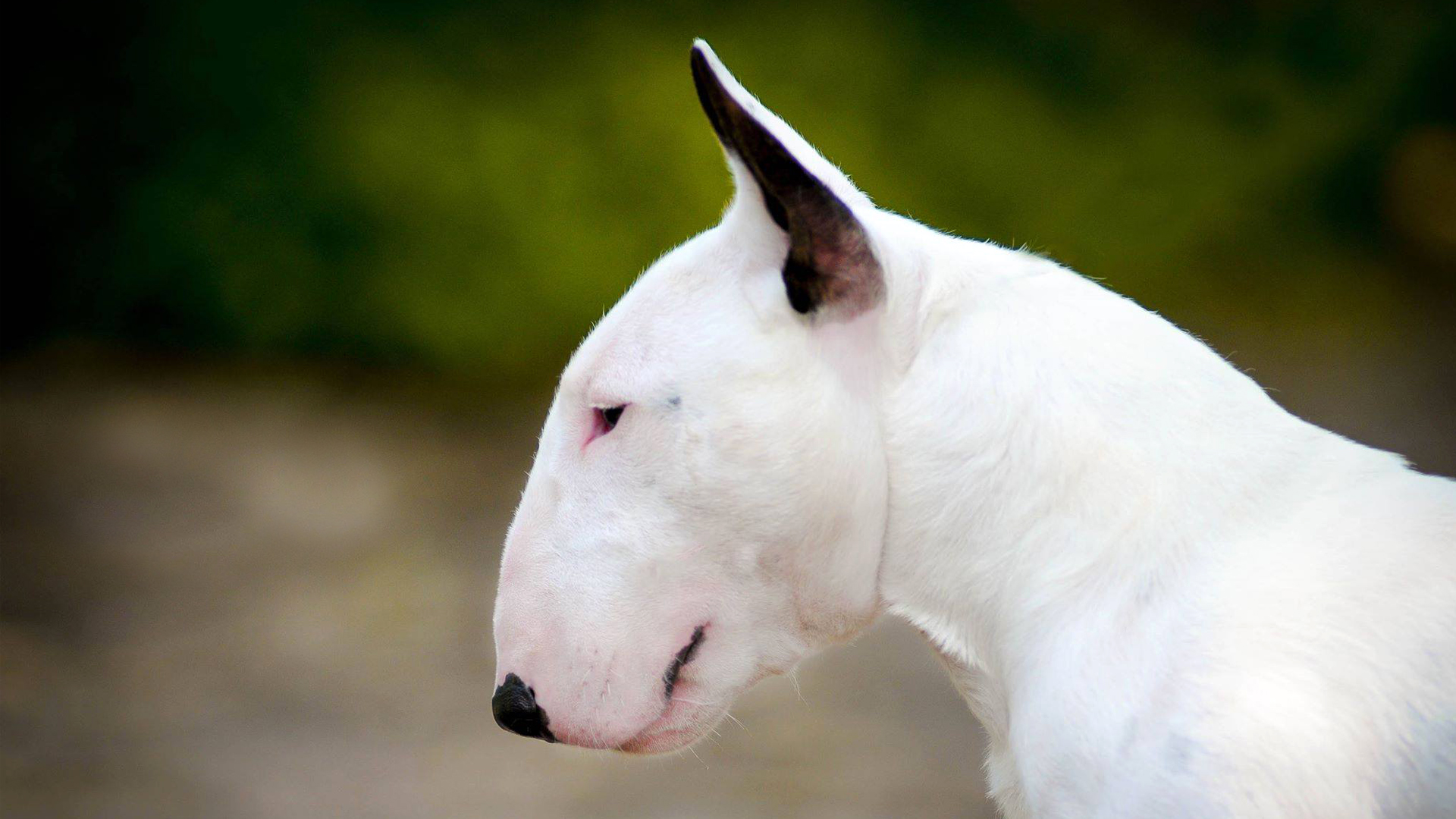
John K. Rosembert Descended from the extinct old English bulldog and Manchester terrier, the bull terrier was originally bred to help control vermin and to fight in the blood sports of bull and bear baiting. Today’s iteration looks as different as he behaves. With the most recognizable feature is its head, described as ‘egg-shaped head’, when viewed from the front; the top of the skull is almost flat. The profile curves gently downwards from the top of the skull to the tip of the nose, which is black and bent downwards at the tip, with well-developed nostrils. The lower jaw is deep and strong. The unique triangular eyes are small, dark, and deep-set, it is a very recognizable breed. The Bull Terrier is a people dog, plain and simple. He’s happiest when he’s with his family so he’s a terrible choice for an outdoor dog. However, that isn’t to say he wants to lie adoringly at your feet. He’d much rather you got up and came outside with him, and went on a short stroll of, say, 10 miles. Those excursions might be a lot more fun if he weren’t an infamous leash-tugger with a tendency to go chasing after every dog, cat and squirrel he sees. Be prepared to train him to listen to you – something he’ll have a hard time seeing the value of much of the time. Training isn’t optional with this breed, unless the idea of a dog weighing between 45 and 80 pounds dragging you all over the neighborhood and ignoring every word you say in your own house appeals to you. Train your Bull Terrier from puppyhood on, with an emphasis on consistency, and you’ll have a well-behaved, well-socialized canine family member. Bull terriers can be protective, especially if they think their family is in danger, so be sure to socialize them around strangers and don’t encourage aggressive or guarding behavior. They can also be protective of their own space, toys, and food. This behavior must be caught early and corrected consistently, as it can lead to serious behavior problems. Common Bull Terrier Diseases & Conditions Symptoms, diagnosis and treatment Patella luxation. Affects Bull Terriers quite often and is simply a disorder that causes the dislocation of the kneecap. Heart Defects and Heart Disease. Heart defects in Bull Terriers are also quite common and can include cardiac valves that leak or valves that are too narrow to transport blood in the required amount. These defects can result in heart murmurs or irregular heartbeats. Symptoms to look out for include: coughing, lethargic behavior, excessive weight loss or weight gain and distressed breathing. See a vet for assistance if you are observing any of these signs. Polycystic Kidney Disease (PKD). PKD affects both the Bull Terrier and the Miniature Bull Terrier. It’s a condition that is inherited and symptoms can start to show at a young age. Polycystic Kidney Disease causes cysts of fluid to form in the kidneys, obstructing them from functioning properly. Look for symptoms like: poor appetite, vomiting, drinking excessively, dry or pale gums and lethargic behavior. Deafness, like any breed, occurs in Bull Terriers and can be detected from as early as four weeks of age. If you believe your Bull Terrier is suffering from a loss of hearing, your vet can perform some tests to determine the situation. https://bowwowinsurance.com.au/dogs/dog-breeds/bull-terrier/ http://www.vetstreet.com/dogs/bull-terrier#grooming Photo credit https://animalscontent.blogspot.com/2019/11/bull-terrier.html
